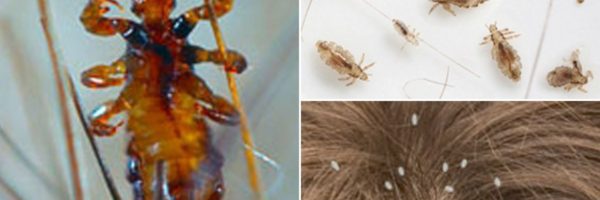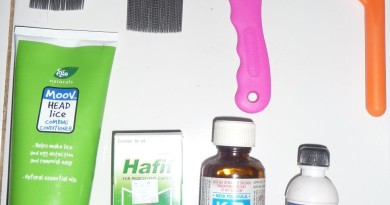Head Lice Alert
Head lice are tiny insects that lay their eggs on hairs next to the scalp. They are very common among school age children. They are usually easy to treat.
What are head lice?
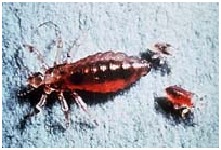
- Head lice are tiny insects without wings. They are about 2-3 mm long, with 6 legs, each with a claw at the end. They crawl quickly, but do not hop, jump or fly.
- They are able to move fast on the scalp, so they are often hard to see.
- It is the nit (egg) which is usually the sign that someone has head lice.
- They feed on human blood, and need the warmth of a human scalp to live.
- Each female louse can lay 150 to 300 eggs, starting from about 2 weeks after hatching.
- They cannot live for long away from the human head. Lice found on carpets, bedding or soft toys are old, sick or dead.
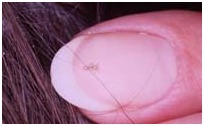 A head louse on a fingernail
A head louse on a fingernail
Nits and hatched eggs
- The eggs (nits) are firmly stuck to the hair, right at the bottom where the hair joins the head.
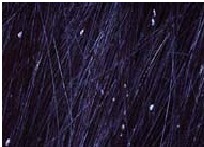
- They are a yellow-white color and less than 1 mm long.
- They hatch about 7 to 10 days after they are laid.
- If they are more than 10 to 15 mm from the scalp (further along the hair) they are dead or hatched.
- Hatched eggs stay stuck to the hair. They are white, flat and usually easy to see.
Who is likely to get head lice?
- Primary school age children are the ones mostly likely to have head lice, but anyone who has had head to head contact with someone who has head lice could get them.
- Children are more likely than adults to be close to each other (eg at school or child care).
- Other family members are likely to get them as well.
- Adults may have them without knowing that they do (they may not get any itching), and they can pass them on to others, especially family members.
How do head lice spread?
- Head lice mainly spread through close head-to-head touching.
- They may be spread through sharing brushes and hats.
- They are not likely to be spread through bedding, furniture or carpets, as they cannot live and lay eggs away from a warm human scalp.
Pets and head lice
- Human head lice (pediculus humanus capitis) have quite a complicated life cycle and can only feed on human blood. They cannot live for more than a few hours on animals. So there is no risk of pets and children infecting each other.
What health problems do lice cause?
- Head lice are harmless.
- Their bite can be very itchy, and if scratched, the scalp can get infected.
- HIV/AIDS and hepatitis B are not spread by head lice. The only illnesses that they can spread (eg typhus, trench fever) do not occur in Australia.
How to tell if you have head lice
You can look very carefully for lice and nits on the scalp and hair especially around the ears, at back of the neck and under fringes. A good light (such as sun light) and magnifying glass will help, because head lice and eggs are very small.
However the best way is to use hair conditioner and a special head lice comb that you can get from a pharmacy or supermarket.
- Put hair conditioner onto dry hair and comb out any tangles or knots with a normal comb. (Cheap conditioner is fine.)
- Use a head lice comb starting with the comb flat on the scalp and pulling it through to the end of the hair.
- Wipe the comb on a tissue or paper towel and check for lice or nits.
- Comb each section of the hair.
Head lice treatments
The Department of Health in South Australia recommends a combination of using a comb to remove lice and nits (the ‘wet-combing’ method described below is probably the easiest) combined with a chemical treatment.
There are several different types of chemicals, and they need to be used in different ways. They should be used exactly as described on the labels.
- You can get advice about which treatments to use from your chemist or family doctor but check the costs, as some cost a lot more than others that work just as well.
- You can get lotions, foams or shampoos.
- It is important to use them exactly as it says on the container. Some may need to be on for at least 8 hours, while some need only a few minutes. Heat can stop the treatment from working – so do not use a hair dryer on the hair after you have treated the lice.
- Leave at least 24 hours between using hair conditioner and using head lice treatment because chemicals in the conditioner may stop the treatment working well.
- Treatments may be available from schools, at a reduced cost, or sometimes free for school card holders.
- Always treat again 7-10 days after the first treatment to kill any lice that hatched after the first treatment. Not all unhatched eggs will be killed by the treatment. Repeating the treatment kills the newly hatched lice before they start laying eggs.
- Check everyone who has been close to the person with the head lice, especially family members, including adults. Treat them if there are signs of lice. If people have had head lice many times they may no longer get any itching so they may not know they have them, and they keep re-infecting the children. Do not treat people who do not have lice.
- Check eyebrows and eyelashes as well as hair.
- Chemical treatments for head lice include maldison, pyrethrins and permethrin.
Note: Effective treatment for head lice is a legal requirement under the South Australian Public and Environmental Health Act 1987. The child’s parents or guardian are responsible for checking and effectively treating children for head lice.
Treatment warnings
Get advice from your doctor or pharmacist before using treatments on pregnant or breast feeding women, people with sensitive skin and infants under 12 months.
- Wet-combing may be a better choice if you are concerned about using chemical treatments.
- Most of the treatments can be safely used by pregnant women, breastfeeding mothers, or on babies, but check to be sure that what you have chosen is safe. The chemicals should only be used for them if they have live lice.
- Keep the treatment away from eyes, mouth and nose.
- Only use head lice treatments if there are live eggs or lice. Do not use a treatment to try to prevent lice – they won’t work.
- The person giving the treatment should wear plastic gloves so they touch the treatment as little as possible.
- The hair should be left to dry after treatment without using heat. Heat may affect how well the chemical works.
Wet Combing
There is information and pictures about how to do this in the SA Heath pamphlet ‘Head lice control: wet combing and chemical treatment’
- Wet combing works for about 40% of families.
- It must be done on alternate days for at least 3 weeks, until there have been no live lice found for two times.
- It needs to be repeated many times because it does not kill the eggs. Each lot of newly hatched lice need to be removed before they can lay more eggs.
- The idea is to quickly smother the lice to prevent them from moving and then to remove them by hand before they can mature and lay more eggs.
- Wait for at least 24 hours after using a chemical treatment before using conditioner on the hair, because the conditioner can stop the chemical treatment from working well.
- Apply a large amount of hair conditioner to the hair. A cheap one is OK.
- With the conditioner still on the hair, use an ordinary comb to comb the hair and get rid of tangles.
- Carefully comb every part of the hair with a fine tooth head lice comb. (You can get this from a chemist or local council). Place the comb flat against the scalp and comb from the scalp towards the tips of the hair.
- After each stroke of the head lice comb, wipe the comb with a tissue or kitchen paper towel and look for lice on the tissue.
- Comb each section of the hair 5 times.
- Keep doing this until all the hair has been combed with the head lice comb.
- Wash the conditioner out of the hair (having a shower may be an easy way to do this).
- Wash combs in hot water.
When treatment does not work
- This can be caused by:
- Not using the treatment exactly as the directions say.
- Not repeating the treatment 7-10 days after the first treatment.
- Catching head lice again from someone else (treatment does not prevent getting lice, it only treats what is there).
- The head lice may become resistant to the chemical used.
- Check all family members. They may have lice without itching.
- Do other things which may stop children catching them again from other children, like plaiting long hair or tying it back tightly, making sure children do not share hats and brushes, telling them how lice are spread.
- If it seems that the treatment has not worked try a different one. Sometimes head lice become resistant to one treatment. Treatments are sold by several different companies. Check whether a different treatment has a different chemical. It could be the same chemical with a different brand name.
- The places that have been bitten can go on itching for several days after the lice have been killed. Check whether live lice and eggs are still there and it is not just the itch.
- See your doctor if the head lice are still there after you have used two treatments.
Important note
Even if you are having trouble getting rid of head lice, do not use chemicals or other products that are not meant to be put on the hair or skin. Some of these can cause serious harm.
Managing head lice
- While the head lice may be adequately killed by the chemical treatment, some people want to be very sure that their family, or others, cannot catch the lice from bedding, towels, clothes, toys, furniture or carpets.
- Any live lice will be killed by heat. Washing in hot water (over 60ºC), or putting bedding etc. into a hot tumble dryer, or ironing clothing or bedding will kill lice.
- Use of pesticide bombs or steam cleaning carpets is not needed. Vacuuming is sufficient.
- You could put soft toys or other items that cannot be washed or ironed into a plastic bag, and leave them in the sunshine for 2 or 3 days.
Removing nits
While dead nits do not need to be removed to stop the head lice spreading, most people think they should be removed (schools etc. may want you to do this).
- It is difficult to remove nits, as they are strongly glued to the hair.
- Use a fine toothed comb. Metal is probably better because it can cut the individual hair at the point where the nit is attached rather than trying to unglue the nit. Nits can also be picked out by hand.
- Warm vinegar onto the hair may help unstick the nits from the hair.
Alternative treatments.
Many parents do not want to use chemical treatments even when they are claimed to be safe.
- Many ‘natural’ head lice treatments have chemicals in them that are the same as the treatments recommended above (many have pyrethrins). Others have chemicals which have not been proven to be safe, but some may be both safe and effective. We are not in a position to recommend or criticize these treatments.
There are several ways of removing lice without using chemicals, and they can be effective for some families.
Hair Gel
- This has been found to work for some people, presumably by interfering with how the lice move, perhaps preventing mating.
Robi Comb**
- This is a battery operated comb that is used on dry hair and kills or knocks out the lice with small amounts of electricity. The comb then removes the lice from the hair.
- To use it successfully, you need to use it often – 10 to 15 minutes every day for 2 weeks to break the breeding cycle of the lice. It also needs to be carefully maintained to work well.
- The Robi comb does not kill the nits.
Nitpickers Comb**
- Some people who have used this say that it works well and saves time. The comb has rounded teeth so it does not tear the hair. The Nitpickers comb is available at a growing number of pharmacies and local councils.
Hair cutting
- Short hair is easier to treat and comb, but shaving the head and cutting long hair is not necessary. In some communities shaving the head is acceptable. This does protect a person from getting head lice.
Preventing head lice
It is very important to remember that head lice are harmless, but they also cause a lot of distress. Instructions to children like the ones below might lessen the risk of getting head lice but it is more important for children to interact with other children in natural ways.
- Avoid direct head-to-head contact.
- Don’t share brushes, combs, ribbons, hats, helmets, hair ties, or ‘dress-up’ clothes.
- Discourage children from playing with each other’s hair.
- Keep long hair tied back or plaited.
- Check hair regularly (children and adults).
- Have a look at the topics on the Kids’ Health site for ideas about how to help children learn about head lice.
Do not use the chemical treatments to try to prevent getting head lice. They don’t work (head lice can be caught again within hours of treatment), and using them often will increase the amount that children absorb.
In places were hair is brushed a lot (eg 100 strokes each day), it has been claimed that children are less likely to have head lice than in communities where such brushing is not done.

